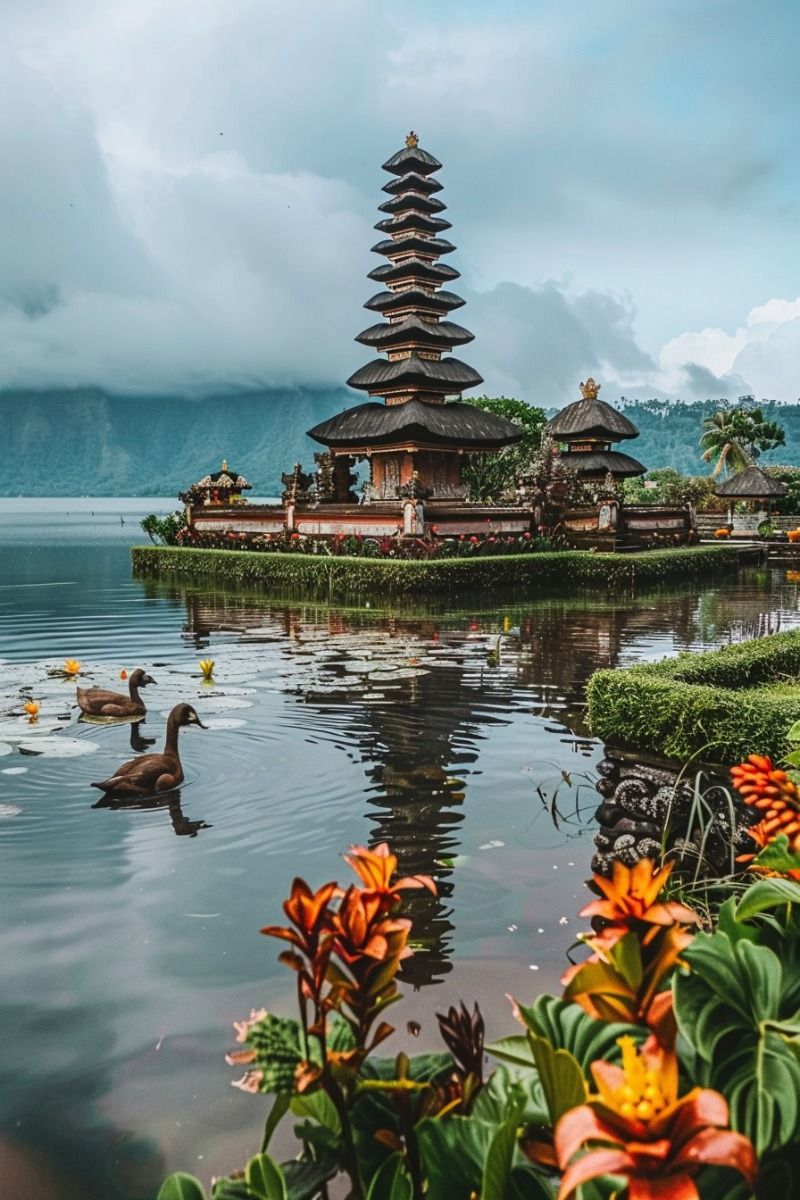
Bali, often dubbed the "Island of the Gods," captivates millions with its stunning beaches, lush rice paddies, and vibrant nightlife. Yet, beneath this picturesque surface lies a profound spiritual and artistic heritage that truly defines its essence. For those planning their inaugural trip, understanding and engaging with the Cultural Wonders of Bali For First-Time Visitors is paramount to experiencing the island’s unique magic beyond the typical tourist façade. This guide will delve into the rich tapestry of Balinese traditions, from ancient temples and mesmerizing dances to intricate crafts and daily rituals, ensuring your first visit is both enchanting and deeply enriching.
The Heart of Balinese Spirituality: Temples and Sacred Sites
Bali’s spiritual landscape is dotted with thousands of temples, each playing a vital role in the daily lives of the Balinese people. These sacred structures are not merely architectural marvels but living testaments to their Hindu Dharma faith, offering a profound glimpse into the island’s soul. Exploring these spiritual sanctuaries is a quintessential cultural experience for any newcomer to Bali.
Uluwatu Temple: Majestic Cliffs and Ancient Rituals
Perched dramatically atop a 70-meter cliff, Pura Luhur Uluwatu offers breathtaking panoramic views of the Indian Ocean, especially at sunset. This ancient sea temple, one of Bali’s six key spiritual pillars, is dedicated to the sea spirits. Visitors can witness the famous Kecak fire dance performed daily as the sun dips below the horizon, a powerful cultural spectacle depicting scenes from the Ramayana epic. Remember to safeguard your belongings from the temple’s resident monkeys, known for their playful antics.
Tanah Lot Temple: Iconic Seascape and Spiritual Significance
Perhaps Bali’s most iconic temple, Tanah Lot, is a majestic structure set on a rock formation amidst crashing waves. Accessible only at low tide, this temple offers an unforgettable sight, particularly during sunset. Dedicated to the guardian spirits of the sea, its mystical aura and stunning natural setting make it a must-visit cultural landmark. The surrounding area also features smaller temples and cultural performances.
Besakih Temple: The Mother Temple’s Grandeur
Nestled on the slopes of Mount Agung, Bali’s highest volcano, Besakih Temple is the largest and holiest temple complex on the island. Known as the "Mother Temple," it comprises over 86 temples and shrines, sprawling across terraces. This sacred site is the spiritual center for Balinese Hinduism, offering an awe-inspiring insight into the island’s deep-rooted faith and architectural grandeur. A guide is recommended here to navigate the complex and understand its significance.
Goa Gajah: The Elephant Cave’s Mystical Allure
Near Ubud, Goa Gajah, or the Elephant Cave, presents a fascinating blend of Hindu and Buddhist imagery dating back to the 9th century. Its main entrance features a menacing mouth carved into the rock, leading into a meditation cave. Inside, visitors will find ancient carvings, a bathing temple with fountains, and a tranquil atmosphere. It’s a significant archaeological site offering a unique cultural journey into Bali’s past.
Tirta Empul Temple: Purification Rituals and Holy Springs
Tirta Empul is a revered Hindu water temple famous for its holy spring water. Balinese worshippers and visitors alike come here to partake in a purification ritual known as Melukat. Submerging oneself in the sacred pools, moving from spout to spout, is believed to cleanse the soul and purify the mind. This immersive experience offers a profound connection to Balinese spiritual practices. Remember to dress respectfully with a sarong and sash, which are usually available for rent.
Practical Tip for Temple Visits: When visiting any temple in Bali, always dress modestly. Both men and women are required to wear a sarong (kain) and a sash (selendang) around their waist. These are often provided at temple entrances, but carrying your own can be convenient. Always be respectful of ongoing ceremonies and local worshippers.
Exploring Balinese Arts and Crafts: A Creative Journey
Beyond its spiritual depth, Bali pulsates with artistic energy. The island is a vibrant canvas where traditional craftsmanship thrives, passed down through generations. For first-time visitors, exploring Bali’s artistic expressions offers a colorful and tangible connection to its cultural identity.
Ubud: Bali’s Artistic Hub for First-Timers
Ubud, often considered the cultural heart of Bali, is a haven for artists, dancers, and musicians. Its streets are lined with galleries, museums, and workshops showcasing an incredible range of Balinese artistry. From intricate wood carvings to contemporary paintings, Ubud provides an unparalleled opportunity to immerse yourself in the island’s creative spirit. Many shops offer authentic handmade goods, and it’s a fantastic place to find unique souvenirs.
Traditional Balinese Dance: Mesmerizing Performances
Balinese dance is more than just entertainment; it’s a sacred ritual, a storytelling art form, and a vibrant expression of religious belief. Dancers, often adorned in elaborate costumes and makeup, use precise hand gestures, facial expressions, and body movements to convey ancient tales from Hindu epics. Popular dances like Barong, Legong, and Kecak offer captivating insights into Balinese mythology and artistic mastery. Attending a performance is an unforgettable cultural highlight.
Balinese Wood Carving and Sculpture: Intricate Masterpieces
The skill of Balinese woodcarvers is legendary. Utilizing various local woods, artisans transform raw materials into exquisite sculptures ranging from mythical figures and deities to delicate decorative pieces. Villages like Mas are particularly renowned for their wood carving traditions, where you can visit workshops, observe carvers at work, and even purchase direct from the artists. These intricate pieces often carry deep symbolic meaning.
Batik and Weaving: Threads of Tradition
Batik, a traditional method of dyeing textiles using wax resist, is a prominent art form in Bali. The patterns and colors used often hold cultural significance, depicting scenes from nature, mythology, or daily life. Similarly, traditional weaving techniques produce beautiful textiles like ‘ikat’ and ‘songket,’ characterized by their intricate designs and vibrant hues. Exploring a batik workshop allows visitors to appreciate the meticulous process and perhaps even try their hand at creating a piece.
Silver and Gold Jewelry: Crafting Elegance
Balinese jewelers are renowned for their intricate designs, often incorporating delicate filigree work and traditional motifs. Villages such as Celuk specialize in silver and gold craftsmanship, where visitors can observe the skilled artisans at work, transforming precious metals into stunning rings, necklaces, and earrings. Purchasing jewelry directly from these workshops often ensures authenticity and supports local communities.
Practical Tip for Art Shopping: When buying art or crafts, try to purchase directly from artisans or reputable galleries. This ensures fair prices for the artists and guarantees the authenticity of your purchase. Don’t be afraid to haggle politely, but always respect the artisan’s craft.
The Rhythms of Bali: Music, Festivals, and Daily Life
Bali’s culture is a living, breathing entity, deeply intertwined with the daily lives of its people. The island’s rhythms are felt in its music, seen in its vibrant festivals, and experienced in its daily rituals, offering first-time visitors a holistic understanding of Balinese cultural richness.
Gamelan Music: The Soulful Soundtrack of Bali
Gamelan, the traditional ensemble music of Bali (and Java), is the island’s enchanting soundtrack. Consisting primarily of percussion instruments like metallophones, gongs, and drums, along with flutes and string instruments, gamelan music is complex, mesmerizing, and deeply spiritual. It accompanies religious ceremonies, dances, and shadow puppet plays (wayang kulit). Hearing a live gamelan performance is an immersive cultural experience that resonates with Bali’s ancient soul.
Balinese Festivals and Ceremonies: A Glimpse into Local Life
Throughout the year, Bali celebrates numerous festivals and ceremonies that are integral to its religious calendar. Galungan and Kuningan, for instance, mark the victory of dharma over adharma, with elaborate decorations (penjor) adorning every street. Nyepi, the Day of Silence, is a truly unique experience where the entire island observes quiet introspection. Witnessing these vibrant events, even from a distance, provides an unparalleled insight into the island’s profound spiritual devotion.
Offerings (Canang Sari): Daily Devotion and Beauty
One of the most ubiquitous sights in Bali is the "Canang Sari," small, intricately woven palm-leaf baskets filled with flowers, rice, cookies, and sometimes money or incense. These daily offerings are placed everywhere – on sidewalks, shrines, in front of shops, and at temples – as a gesture of gratitude and devotion to the gods and to appease malevolent spirits. Observing this daily ritual offers a beautiful insight into the Balinese philosophy of balance and harmony.
Balinese Cuisine: A Culinary Cultural Experience
Exploring Balinese cuisine is a cultural journey in itself. More than just sustenance, food plays a role in ceremonies and daily life. Dishes like Babi Guling (suckling pig), Betutu (slow-roasted duck or chicken), and Nasi Campur (mixed rice with various accompaniments) offer a burst of unique flavors, often spicy and aromatic with local spices. Taking a cooking class can provide a hands-on experience, teaching you about the ingredients and traditional preparation methods, further deepening your appreciation for Balinese culture.
Connecting with Local Traditions: Immersive Experiences
For those seeking to move beyond observation and truly connect with the Balinese way of life, several immersive experiences offer deeper engagement with local traditions. These opportunities allow first-time visitors to interact with the culture on a more personal level.
Rice Terraces: Sustenance and Scenery
The iconic rice terraces of Bali, such as those in Jatiluwih (a UNESCO World Heritage site) and Tegalalang, are not just stunning landscapes but also a testament to the sophisticated "Subak" irrigation system – a democratic and cooperative system of water management that reflects Balinese philosophical principles. Trekking through these emerald fields offers a chance to appreciate the agricultural heart of the island and the communal spirit that sustains it.
Balinese Cooking Classes: Savoring Local Flavors
Participating in a Balinese cooking class is an excellent way to delve into the local culinary traditions. Often starting with a visit to a traditional market to select fresh ingredients, these classes teach you how to prepare authentic Balinese dishes using local spices and techniques. It’s a fun, interactive way to understand the role of food in Balinese culture and take a delicious piece of Bali home with you.
Visiting Traditional Villages: Authentic Encounters
Venturing into traditional villages like Penglipuran or Tenganan allows first-time visitors to witness Balinese life largely untouched by modern tourism. These villages often preserve ancient architectural styles, unique customs, and traditional crafts. Engaging with the local community, observing their daily routines, and learning about their unique heritage provides an authentic and heartwarming cultural experience. Always be respectful and ask for permission before taking photographs.
Balinese Healing and Wellness: Ancient Practices
Bali is renowned for its traditional healing practices, deeply rooted in ancient wisdom and natural remedies. From traditional massage (Balinese massage) to herbal medicine and spiritual healing (balian), these practices aim to restore balance and harmony to the body, mind, and spirit. Many resorts and wellness centers offer these experiences, providing a serene way to connect with Bali’s holistic approach to well-being.
Tips for First-Time Visitors: Embracing Bali’s Cultural Heritage
To make the most of your cultural exploration in Bali, here are some practical tips specifically tailored for first-time visitors:
- Respect Local Customs and Dress Codes: Always dress modestly when visiting temples or attending ceremonies. Carry a sarong and sash, or be prepared to rent them. Remove your shoes when entering homes or certain sacred spaces.
- Engage with Locals (Politely): Balinese people are generally warm and welcoming. A smile and a simple "Om Swastiastu" (a common Balinese greeting) can open doors to friendly interactions. Be curious but always respectful of their privacy and traditions.
- Support Local Artisans and Businesses: When purchasing souvenirs or dining, prioritize local vendors and establishments. This directly supports the Balinese community and helps preserve traditional crafts and cuisine.
- Be Mindful of Your Environment: Bali is a beautiful island, but it faces environmental challenges. Be a responsible traveler by minimizing waste, conserving water, and supporting eco-friendly initiatives.
- Learn Basic Balinese/Indonesian Phrases: Even a few simple phrases like "Terima kasih" (thank you), "Tolong" (please), and "Berapa harganya?" (how much is it?) can greatly enhance your interactions and show respect for the local culture.
- Embrace the Pace of Life: Bali operates on its own rhythm. Be patient, flexible, and open to unexpected detours. Sometimes, the most memorable cultural experiences happen spontaneously.
Conclusion
Bali is undeniably a paradise, but its true allure lies in the profound beauty of its culture and the warmth of its people. For first-time visitors, moving beyond the beaches to immerse oneself in the island’s spiritual sanctuaries, vibrant arts, daily rituals, and rich traditions promises an experience that transcends a typical vacation. By respectfully engaging with the Cultural Wonders of Bali For First-Time Visitors, you won’t just see the island; you’ll feel its soul, creating memories that are not only picturesque but deeply meaningful. So, pack your bags, open your heart, and prepare to be enchanted by the timeless magic of Bali.







